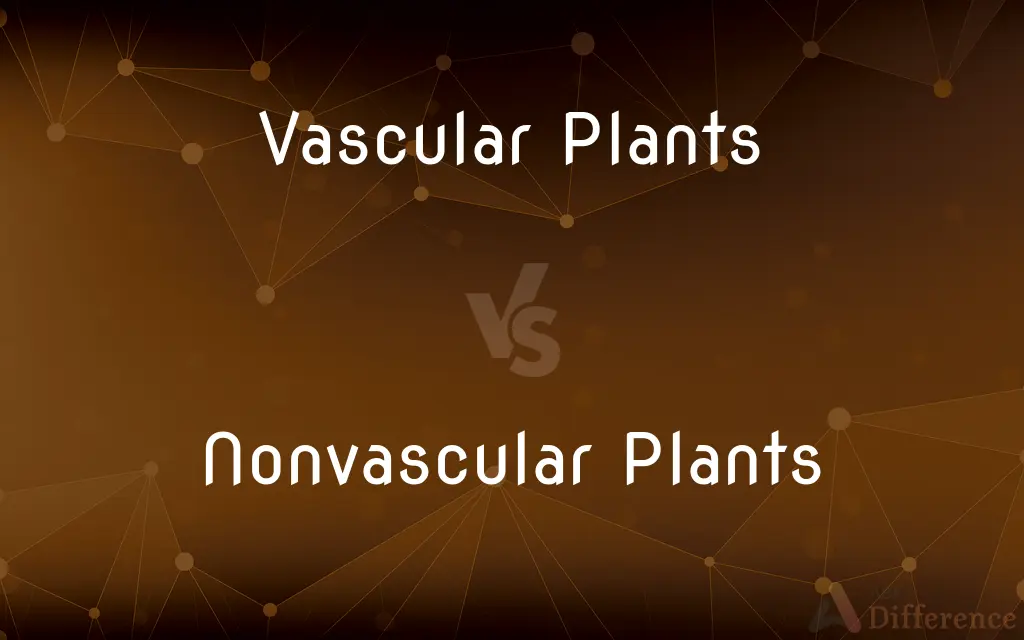Vascular Plants vs. Nonvascular Plants — What's the Difference?
By Tayyaba Rehman & Maham Liaqat — Published on March 5, 2024
Vascular plants have specialized structures for nutrient transport, while nonvascular plants lack these and rely on direct water absorption.

Difference Between Vascular Plants and Nonvascular Plants
Table of Contents
ADVERTISEMENT
Key Differences
Vascular plants are characterized by the presence of xylem and phloem, which facilitate the transport of water and nutrients throughout the plant. This system allows them to grow taller and thrive in a variety of environments. Nonvascular plants, on the other hand, do not have these specialized transport tissues, which limits their size and makes them dependent on moist environments to facilitate direct water absorption.
Nonvascular plants, including mosses, liverworts, and hornworts, are typically found in damp, shaded areas where they can absorb water and nutrients directly from their surroundings. This reliance on their immediate environment for water absorption constrains them to specific habitats. Vascular plants, with their advanced transport systems, are more versatile, enabling them to inhabit a wider range of environments, from dry deserts to wet forests.
The reproduction of nonvascular plants often involves the production of spores, which are dispersed by wind or water. Without the need for a vascular system to distribute water and nutrients, these plants can reproduce in their preferred moist conditions. Vascular plants, however, reproduce through a variety of means, including seeds and spores, with some having complex reproductive structures like flowers and fruits that aid in the dispersal of seeds.
Vascular plants have developed roots, stems, and leaves, which contribute to their structural support and efficiency in photosynthesis and nutrient transport. Nonvascular plants lack these distinct structures, which affects not only their form and size but also their ability to compete for light and nutrients in more diverse ecosystems.
The ecological roles of vascular and nonvascular plants also differ significantly. Vascular plants are key contributors to many ecosystems, providing habitat and food for various organisms. Nonvascular plants play crucial roles in water retention and soil formation in their specific habitats, highlighting the diversity of plant life and its adaptation to the environment.
ADVERTISEMENT
Comparison Chart
Presence of Specialized Transport Tissues
Yes (xylem and phloem)
No
Habitat Versatility
High (varied environments)
Low (moist environments)
Reproductive Structures
Seeds and spores, flowers, and fruits
Primarily spores
Growth Height
Taller, due to structural support
Shorter, due to lack of support tissues
Role in Ecosystem
Diverse, including structural habitat and food source
Water retention, soil formation
Compare with Definitions
Vascular Plants
Many vascular plants reproduce through seeds.
Flowering plants produce fruits that contain seeds.
Nonvascular Plants
They lack true roots, stems, and leaves.
Mosses have root-like structures called rhizoids for anchorage.
Vascular Plants
They are key contributors to many ecosystems.
Grasses serve as a primary food source in savannas.
Nonvascular Plants
Nonvascular plants lack xylem and phloem.
Moss absorbs water directly through its leaves.
Vascular Plants
Vascular plants have roots, stems, and leaves.
The roots of ferns anchor them into the ground and absorb water.
Nonvascular Plants
Nonvascular plants reproduce mainly through spores.
Hornworts release spores that are dispersed by water.
Vascular Plants
Vascular plants are characterized by having xylem and phloem.
Oak trees use their vascular system to transport nutrients from soil to leaves.
Nonvascular Plants
They play a crucial role in water retention and soil formation.
Moss beds retain moisture and prevent erosion.
Vascular Plants
They typically grow taller and can live in various environments.
Pine trees thrive in both moist and dry conditions.
Nonvascular Plants
They are typically found in damp, shaded areas.
Liverworts thrive on moist forest floors.
Common Curiosities
How do vascular and nonvascular plants differ in habitat?
Vascular plants can inhabit a wide range of environments, while nonvascular plants typically need moist environments.
How do vascular plants reproduce?
Vascular plants reproduce through seeds and spores, with some having flowers and fruits for seed dispersal.
What are nonvascular plants?
Nonvascular plants are plants that lack specialized tissues for water and nutrient transport, relying on direct absorption.
Can nonvascular plants grow as tall as vascular plants?
No, nonvascular plants are generally shorter due to the absence of specialized support tissues.
What are vascular plants?
Vascular plants are plants that have specialized tissues (xylem and phloem) for water and nutrient transport.
Do nonvascular plants have roots?
Nonvascular plants do not have true roots; they have structures like rhizoids for anchorage.
How do nonvascular plants absorb water?
Nonvascular plants absorb water and nutrients directly from their surroundings, without transport tissues.
What is the main difference in the reproductive system of vascular and nonvascular plants?
Vascular plants often reproduce through seeds, while nonvascular plants primarily use spores.
Why can vascular plants grow in diverse environments?
Vascular plants have a sophisticated transport system and structural support, allowing them to adapt to various conditions.
What is the significance of xylem and phloem in vascular plants?
Xylem and phloem are crucial for the transport of water, nutrients, and sugars throughout the plant.
Are mosses considered nonvascular plants?
Yes, mosses are nonvascular plants because they lack xylem and phloem for water and nutrient transport.
How do vascular plants contribute to ecosystems?
Vascular plants provide structural habitat, food, and contribute to the carbon cycle in various ecosystems.
Are all vascular plants seed-producing?
No, not all vascular plants produce seeds; some, like ferns, reproduce via spores.
What roles do nonvascular plants play in the ecosystem?
Nonvascular plants help in water retention and soil formation, especially in moist habitats.
Can nonvascular plants live in dry environments?
Nonvascular plants generally require moist environments to survive due to their direct absorption method.
Share Your Discovery

Previous Comparison
Prejudice vs. Racism
Next Comparison
Moss Green vs. Sage GreenAuthor Spotlight
Written by
Tayyaba RehmanTayyaba Rehman is a distinguished writer, currently serving as a primary contributor to askdifference.com. As a researcher in semantics and etymology, Tayyaba's passion for the complexity of languages and their distinctions has found a perfect home on the platform. Tayyaba delves into the intricacies of language, distinguishing between commonly confused words and phrases, thereby providing clarity for readers worldwide.
Co-written by
Maham Liaqat















































